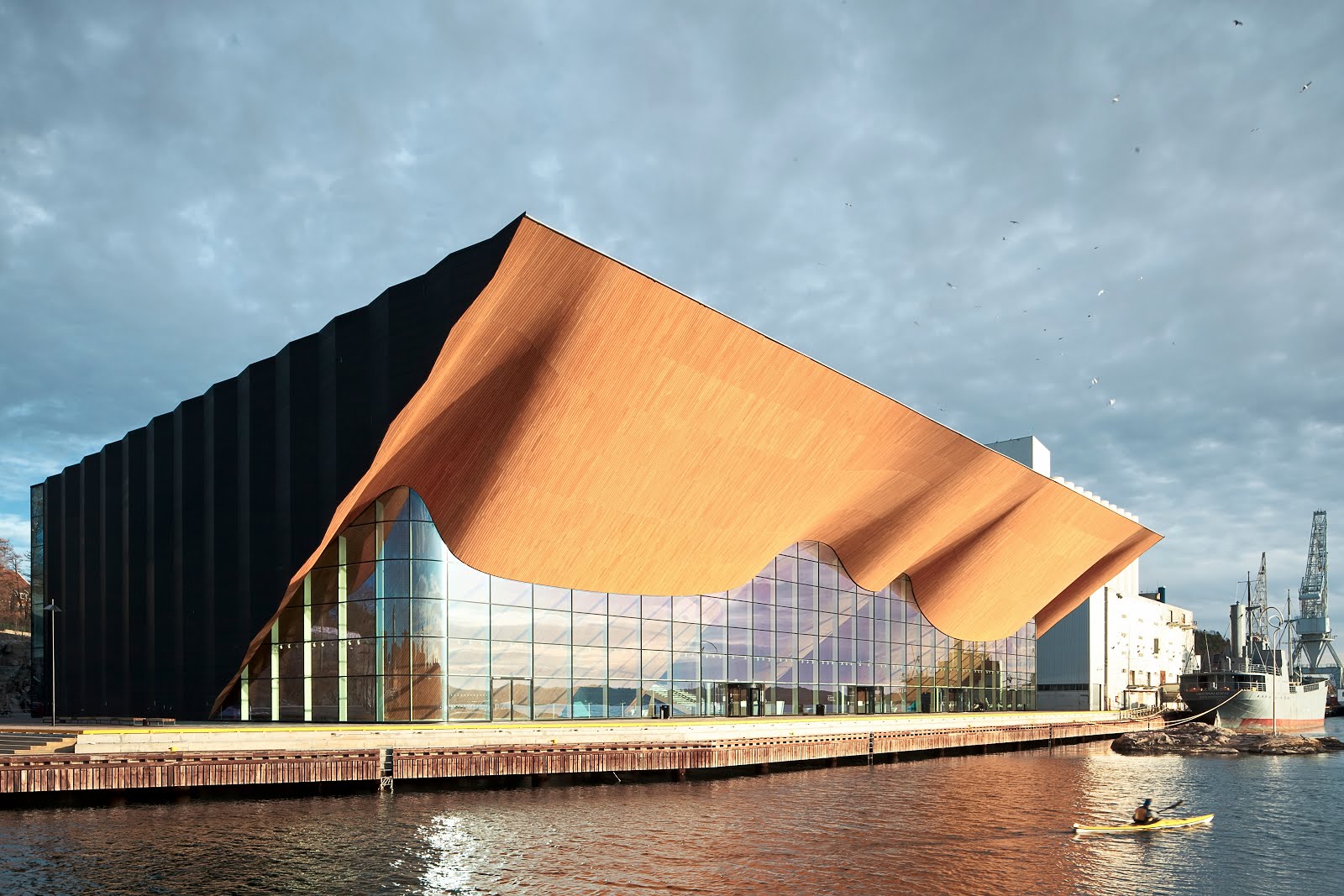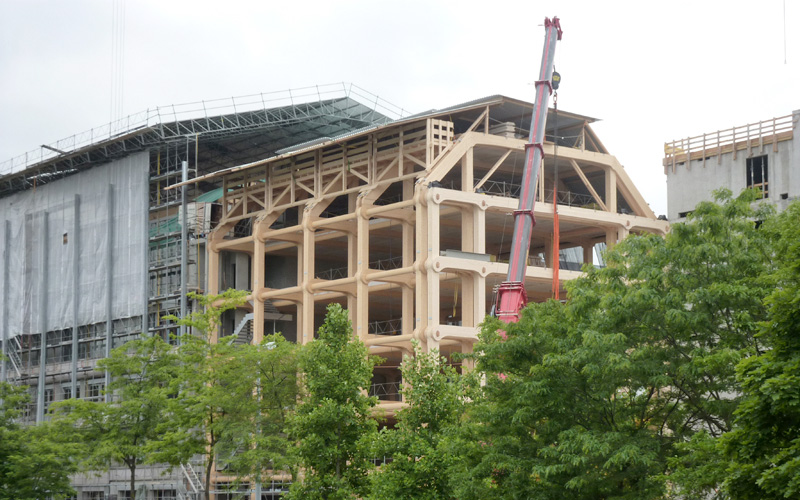Wood buildings come back in favour

Timber construction is undergoing a renaissance. Architects are now pushing the boundaries of what can be done with wood, erecting cutting-edge office towers and industrial domes, thanks in large part to Swiss expertise.
One of the highest profile examples of the trend in Switzerland is the new Zurich headquarters of media company Tamedia. The seven-storey structure, including its joints, is entirely made out of wood and has no steel reinforcements. This makes it quite unique, says Christoph Zimmer, head of corporate communications at Tamedia.
It also made the design by Japanese architect Shigeru Ban quite challenging to build, as each wooden element had to be cut specially and then assembled on site. This is where a specialist Swiss timber firm, Blumer-Lehmann, came in.
Based in rural Gossau, in northern Switzerland, the company site still boasts its original founding sawmill of 1875. It also remains in the hands of the Lehmann family. But looking around its workshops – with sawdust underfoot and the smell of wood in the air – it is clear that timber construction nowadays is a high-tech affair.
“Today many architects can use computer-assisted design programmes to design all sorts of shapes in wood, but these shapes have to be executed. That’s a speciality that we have very strongly developed in the past three to four years,” Richard Jussel, in charge of wood construction at the company, told swissinfo.ch.

More
Zurich hosts a world timber first
Old and new
The huge elements that make up the Tamedia building – each 24 metres long and weighing two tonnes – were made with the aid of computers. Everything had to be calculated down to the last millimetre, to ensure that all the elements fitted together.
It was quite a challenging project, even for a company as experienced as Blumer-Lehmann, admitted Jussel. The company, considered a leader in its field, won out against several others to gain the contract for what has been hailed as the tallest building of its kind in the world.
The Tamedia building is just one of many innovative wooden structures springing up across the country. Ban himself is involved in another high-profile project, the curved wooden headquarters for the Swatch Group watchmakers in Biel, which should be ready in 2015.
Elsewhere, the Schweizer Rheinsalinen salt company recently constructed Europe’s biggest wooden dome to store its winter thawing salt. And the country’s largest wooden housing development is being built in Mellingen in canton Aargau.

More
A truly unique building
Long time coming
That there is a general boom in timber construction in Switzerland has been confirmed by both the 2012 Swiss Wood Final Consumption report and the timber industry’s parent organisation, Lignum.
Lignum spokesman Michael Meuter said that the trend had, however, been a long time coming. At the beginning of the 20th century, wood use was still traditional, such as for chalets or railway stations. Steel and concrete were the building materials of choice. It wasn’t until the end of the 1980s that there was any real interest in wood.
Then came technological developments, such as computer-aided design and manufacturing, and investment in training, such as in timber construction engineering – a Swiss invention. “This was pioneering, the training of people who understood about building with timber from an engineering perspective,” Meuter told swissinfo.ch.
Fire regulations were also relaxed in 2004, which allowed wood to be used in six-storey-plus buildings.
In addition, there is now an image boost to using wood and combining it with Swissness – as seen in the Tamedia building. “It’s prestige architecture,” Meuter said.
Another attractive factor is that wood is sustainable and uses less CO2 in the building process than other materials.
Industry effects
The effect of the boom can be seen on the industry. “The big wood construction companies have doubled their capacity,” Meuter said of the firms which cut precision elements for buildings.
“On the other hand, the sawmills for example are not affected because Swiss wood is not used as much as European wood. It is more expensive and so at a disadvantage.”
Blumer-Lehmann itself has tripled in size and employees and recorded a ten-fold increase in revenue over the last 30-40 years – the timeframe in which it has seen a boom in the use of its services.
Jussel said that nowadays there is a good network of wood engineers and architects willing to work with wood. He also pointed to good training – which is essential to his company.
The trend towards timber construction is confirmed in the 2012 Swiss Wood Final Consumption report. It showed that the final use of wood as a manufacturing material in Switzerland rose from 2.52 million cubic metres in 2001 to 2.77 million cubic metres in 2009, with the largest percentage – 45 per cent – being used in construction.
“The biggest rise is in flats and among the big developments we see almost a doubling [in timber use],” said Birgit Neubauer-Letsch from the Bern University of Applied Sciences in Biel, which did the study in collaboration with the Federal Environment Office. “We also see a rise in commercial buildings, particularly smaller ones, and in halls.”
First results for 2012 show another increase in wood use in construction across Switzerland.
Wood is also a popular material for use in extensions and renovations (around 30 per cent timber use for both flats and family homes). More timber is expected to be used in flats than in family home extensions and renovations for the first time in 2012.
Leader
Architect Ban has called Swiss timber technology know-how “the most advanced worldwide” (see related interview).
Meuter believes that the country is the leader in wood construction – just ahead of Austria and Germany. Indeed, its experts are very much in demand worldwide – Blumer-Lehmann has worked in South Korea and Norway, for example.
Timber construction engineer Hermann Blumer – who has no current association with Blumer-Lehmann – is known as the man to go to when all else fails. It was he who worked out how to do the wood joints for the Tamedia building.
Blumer, who has worked with Ban on other projects, told swissinfo.ch that this had been a challenge but he took an idea from the old art of timber construction.
The timber industry may be relatively small – akin to the watch industry – but there are “clever people” that are helping steer it in the right direction, added Meuter.
So it can safely be said that timber construction in Switzerland is more than just traditional chalets. “Wood can these days go beyond that, which makes it so exciting,” Meuter said.
Net production is CHF7.6 billion ($8.2 billion) – a 1.8% share of Gross Domestic Product. The industry employs around 80,000 people and there are around 12,000 companies – most are small and medium-sized enterprises, often in rural areas where there are fewer employment opportunities.
The biggest employers in the sector are carpenters (timber building industry), flooring, cabinet-makers and interior fittings and the furniture industry.
Lignum is the parent organisation of the timber industry, covering the whole process from forestry, sawmills, and building to packaging and paper. It was founded in 1931 as a way of giving the then ailing industry a boost.
Lignum organises the Prix Lignum every three years for the innovative use of wood, not only in construction, but also interiors, furniture and artworks. The last prize was given in 2012. Lignum’s Michael Meuter said that they used to have to search for buildings that used timber for the prize, but now they can pick and choose from projects – another sign of the boom.
(Source: Lignum)

In compliance with the JTI standards
More: SWI swissinfo.ch certified by the Journalism Trust Initiative









You can find an overview of ongoing debates with our journalists here . Please join us!
If you want to start a conversation about a topic raised in this article or want to report factual errors, email us at english@swissinfo.ch.